Peter Sutcliffe or “The Harrogate Ripper”?
by Tim Hicks and Chris Clark
~~~~~
CHRIS CLARK is a retired Police Intelligence Officer with twenty-eight years service, mainly working in police intelligence. For more information on Chris, please see his website here. TIM HICKS is our crime reporter and followed the Yorkshire Ripper investigation as a young man.
Background: The Yorkshire Ripper
The Yorkshire Ripper investigation in 1975 – 1981, was up to that time the biggest murder investigation ever undertaken in Britain. For those that are unfamiliar with the Yorkshire Ripper case, there is a very good documentary here.
In 1981 Peter Sutcliffe – a married lorry driver from Bradford was convicted of murdering thirteen women and attempting to murder another seven women between 1975 and 1980. He confessed to another two attempted murders and it has been stated in the press that West Yorkshire Police (WYP) are confident they have enough evidence to send a file to the CPS on another two, but have decided not to proceed to prosecution.
In total, he is known to have committed fourteen murders and eleven attempted murders. The list of these is shown below in Table 1, with a reference to the map below:

Map showing the locations of the offences for which Sutcliffe was convicted
Following the conclusion of Sutcliffe’s trial, the Home Office tasked Chief Constable Lawrence Byford of HM Inspectorate of Constabulary to conduct a review of the WYP Yorkshire Ripper investigation. Sir Lawrence found there was an “unexplained lull” in the Ripper’s activities between 1969 and 1975:
“We feel it is improbable that the crimes in respect of which Sutcliffe has been charged and convicted are the only ones attributable to him. This feeling reinforced by examining the details of a number of assaults on women since 1969 which in some ways, clearly fall into the established pattern of Sutcliffe’s overall modus operandi…”
“It is my firm conclusion that between 1969 and 1980 Sutcliffe was probably responsible for many attacks on women, which he has not admitted, not only in West Yorkshire and Manchester but also in other parts of the country….”
Sir Lawrence went on to deduce that Sutcliffe could have been responsible for a further thirteen offences. However, that section of his report specifying the names of these thirteen victims and the reasoning behind his deductions were withheld from the public.
Two additional investigations by Assistant Chief Constable Samson and the then by Assistant Chief Constable Hellawell of WYP were never released.
Although the Yorkshire Ripper murder investigation was unquestionably the largest ever undertaken by the British police service up to that time and there was widespread public interest in the case. No official estimate of the full range of Sutcliffe’s offending has ever been released.
There are a number of reasons why this investigation has been shrouded in official secrecy by the police. They are covered in an NYE article Yorkshire Ripper – How Many Victims?
Partial release of the Byford Report
Following an unsuccessful attempt by Chris in 2013 to have the withheld parts of the 1981 Byford Report placed into the public domain, Jonathon Corke of the Sunday Times took up the refusal and progressed it to the Information Commissioner. In July 2016 following pressure from Chris and in conjunction with Jonathan Corke of The Sunday Times, a further four pages of the Byford Report were released with the victims’ names redacted.
“Reference: FS506234411
Freedom of Information Act 2000 (FOIA)
Decision notice
Date: 21 July 2016
Public Authority: Home Office
Address: 2 Marsham Street
London
SW1P 4DF
The complainant requested previously unpublished content from the report “The Yorkshire Ripper Case: Review of the Police Investigation of the Case”. The Home Office refused to disclose this information and cited the exemptions provided by the following sections of the FOIA:
31(1)(a) (prejudice to the prevention or detection of crime) 31(1)(b) (prejudice to the apprehension or prosecution of offenders) 31(1)(c) (prejudice to the administration of justice) 38(1) (endangerment to health and safety) 40(2) (personal information)
The Commissioner’s decision is that sections 31(1)(a), (b) and (c) were cited correctly in relation to some of the content, but that other parts of the content should be disclosed. The Commissioner also finds that sections 38(1) and 40(2) were cited correctly in relation to some limited parts of the content.
The Home Office is now required to disclose the withheld information, minus the content which he has found exempt. The Commissioner requires the Home Office to take the following steps to ensure compliance with the legislation. Disclose the withheld information with the redactions described in paragraph 49. 4. The Home Office must take these steps within 35 calendar days of the date of this decision notice. Failure to comply may result in the withheld information, minus the content which he has found exempt. Commissioner making written certification of this fact to the High Court pursuant to section 54 of the FOIA and may be dealt with as a contempt of court. The effect of this notice is that the Home Office should disclose the requested information, but with the names of living or deceased individuals whose names have not been disclosed elsewhere in the Byford Report redacted and with the sections on Photofits and “Other Possible Assaults Committed by Sutcliffe” also withheld.”
The Home Office were granted a right of appeal against the Information Commissioner’s decision, which in the event the Home Office chose not to exercise.
The originally withheld portion of the Byford Report that was released as a result of the Information Commissioner’s decision is shown below, with names redacted:
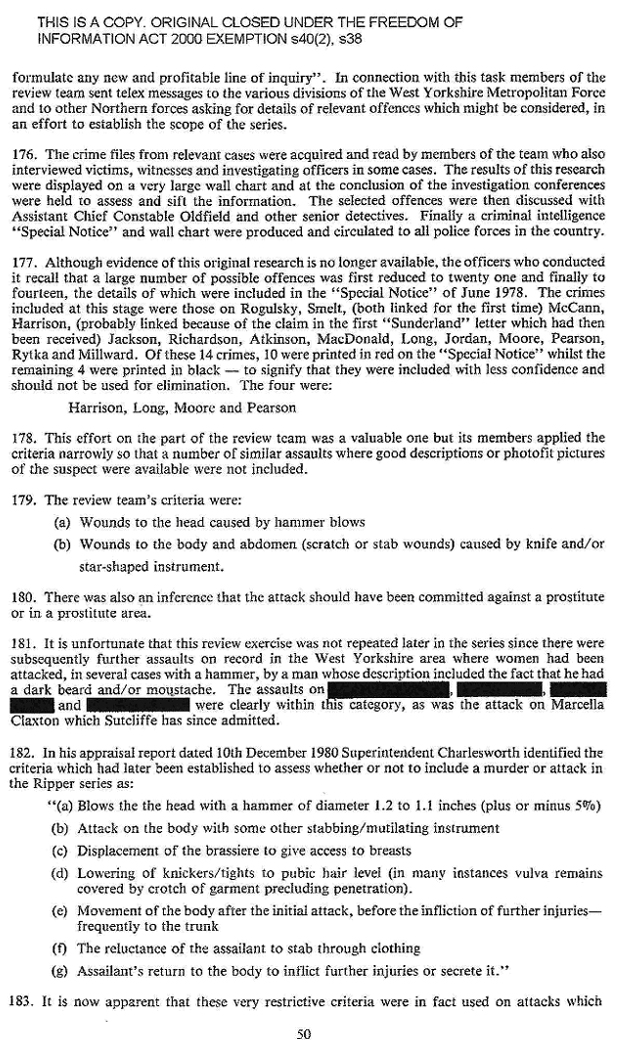
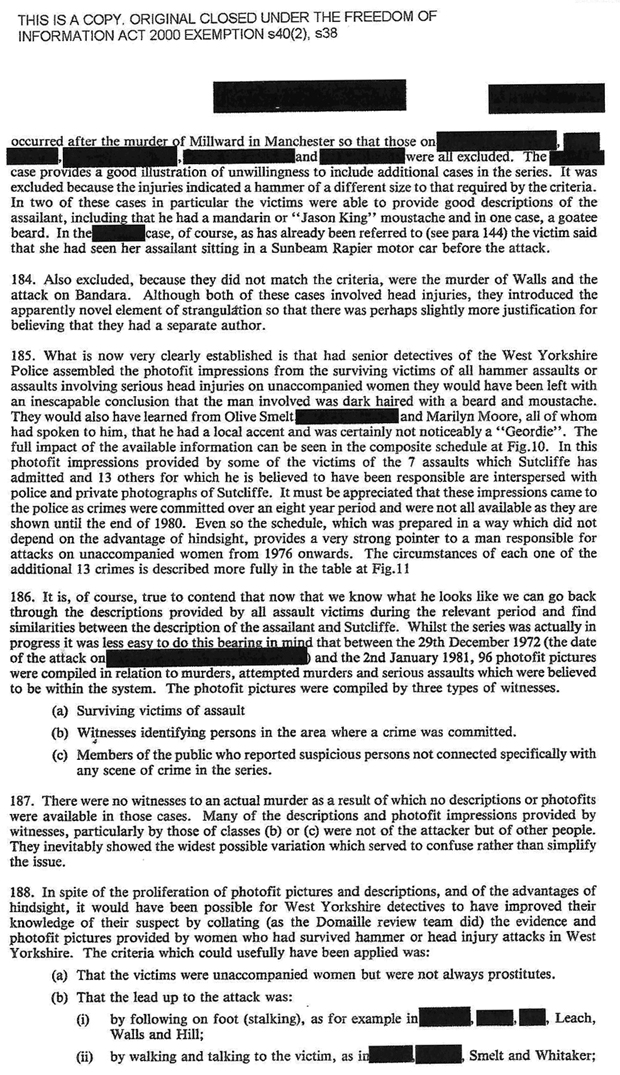
Review of “The Psychology of Serial Killer Investigations” by Robert D Keppel an Associate Professor of Criminal Justice at San Houston State University, Huntsville, Texas, USA revealed that Professor Keppel had obviously obtained access to the complete Byford Report prior to 2003 when the book was published by Academic Press. Within the book Professor Keppel names most of the thirteen additional victims named in the Byford Report, that the Home Office and West Yorkshire Police had redacted, to withold from the British Public.

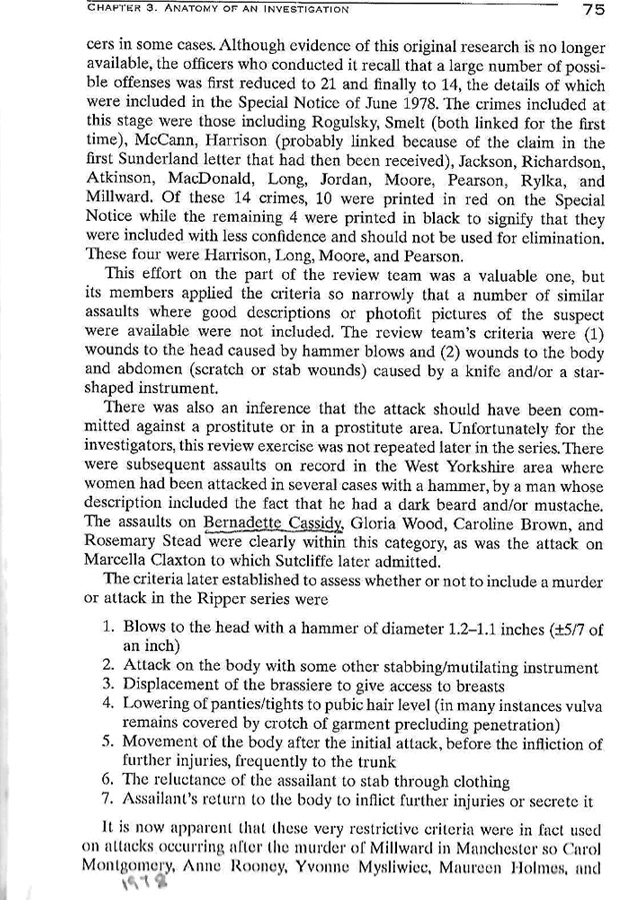
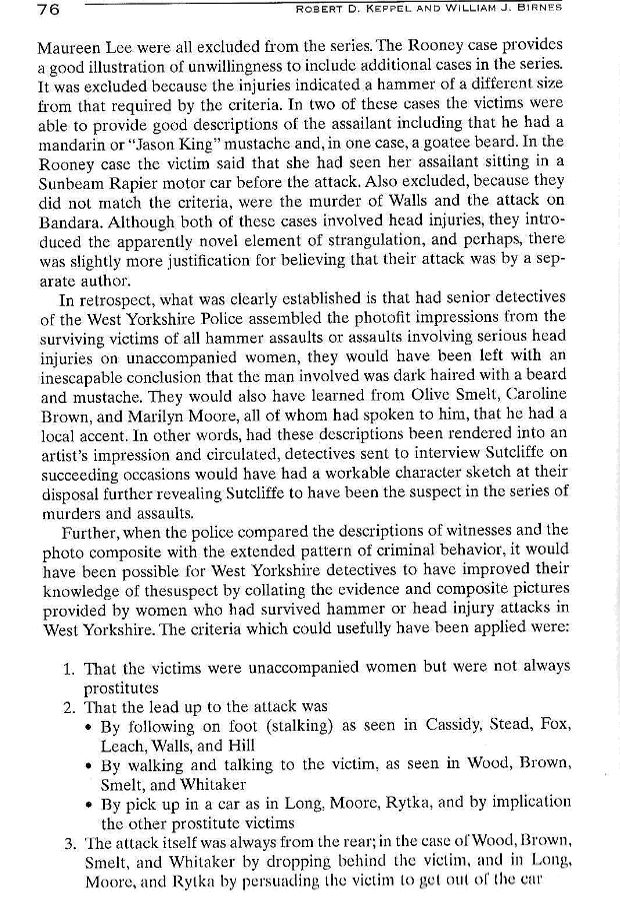
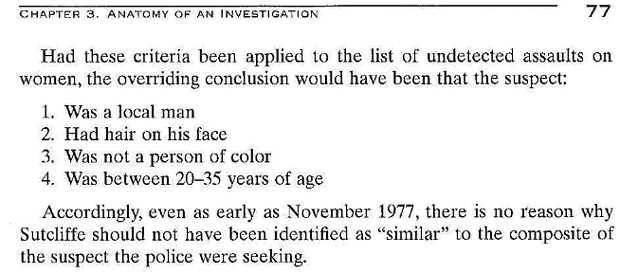
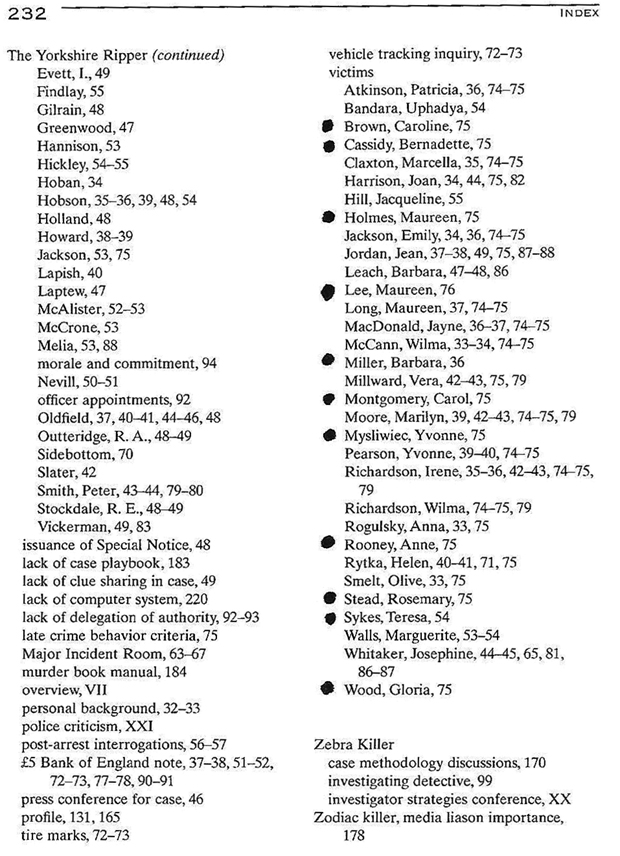
Did Sutcliffe operate in North Yorkshire?
Sutcliffe was a lorry driver who drove all over England and who had lived in London. Yet, as shown above, all of the offences that have been assessed as having been committed by him are tightly grouped around Manchester, Bradford, Halifax, Leeds, Sheffield and Huddersfield in the West Yorkshire Police (WYP), South Yorkshire Police (SYP) and Greater Manchester Police (GMP) areas. This clearly lacks credibility. Sutcliffe operated across England as part of his work and social life. He did not limit his travel to Yorkshire and Manchester and there was no reason he should limit his crimes to this small area.
However, until the publication of the book “Yorkshire Ripper The Secret Murders” in 2015 by Chris Clark and award winning investigative journalist Tim Tate, there was no credible assessment in the public domain of the full range of Sutcliffe’s offending. (As well as being an author, film maker and award winning investigative journalist Tim Tate covered the Yorkshire Ripper investigation as a young reporter on the Keighley News).

In the absence of any coherent assessment of the full extent of Sutcliffe’s crimes from the police. Chris and Tim published an updated assessment in their NYE article: Yorkshire Ripper – How Many Victims?. This is believed to be the most accurate assessment of the full range of crimes committed by Peter Sutcliffe that is publicly available.
However, the list has been prepared only from what is in the public domain, without access to police sources. It is possible that some cases will be eliminated by the police and other cases will be assessed as being the work of Peter Sutcliffe. So the tables will be updated on an ongoing basis for developments.
They have recently been updated to include the “Nude in the Nettles” murder which was committed in North Yorkshire in about 1979 and which was covered in the NYE article Nude in the Nettles – Was it Sutcliffe.
During the course of their research, Chris Clark and Tim Tate tried to identify the thirteen cases identified as Ripper attacks by Sir Lawrence Byford in his 1981 investigation. Using the information above, they believe they were able to identify twelve of them. One of these was the mysterious attack in Harrogate on a sixteen year old schoolgirl whose name has never been released by North Yorkshire Police. She is referred to as “Miss M” in the extract from “Wicked Beyond Belief” by Michael Bilton below.
Attempted murder in Harrogate on the 18th February 1979. Peter Sutcliffe or the Harrogate Ripper?
Concerning the facts of the Harrogate attack, I can do no better than quote from “Yorkshire Ripper The Secret Murders” by Chris Clark and Tim Tate, and from “Wicked Beyond Belief” by Michael Bilton. The Harrogate attack took place less than fifteen miles from West Yorkshire Police HQ in Leeds, but under the completely separate jurisdiction of North Yorkshire Police. It might just as well have taken place on another planet:
Extract from “Yorkshire Ripper The Secret Murders” by Chris Clark and Tim Tate (Pages 263 – 4):
“In the early hours of Sunday 18 February, a sixteen-year –old student was hit from behind with an all-too-familiar blunt instrument. She survived, though suffering from severe head injuries she was not able to give a description of her attacker as she had not seen him.
What happened next was straight out of the Keystone Cops School of investigation. North Yorkshire Police decided that the young woman had injured herself by falling on the icy pavement and that therefore no crime had taken place. They maintained this incredible fiction even after Home Office pathologist (and consulting Ripper expert) Professor David Gee examined the victim at Leeds General Infirmary and discovered deep and serious skull damage. He noted that “there was one linear laceration on the left side of the top of the head two and a half inches long and on the right side of the top of the head two inches long. A third curved laceration at the back of the head was about one inch long.
It would take several years for the North Yorkshire force to concede that these could not have been caused by an accidental fall and that the student had suffered a vicious attack. But still no connection was made to the unprecedented and enormously high profile hunt for Britain’s most notorious smasher of the back of women’s skulls being conducted by the Ripper teams.”
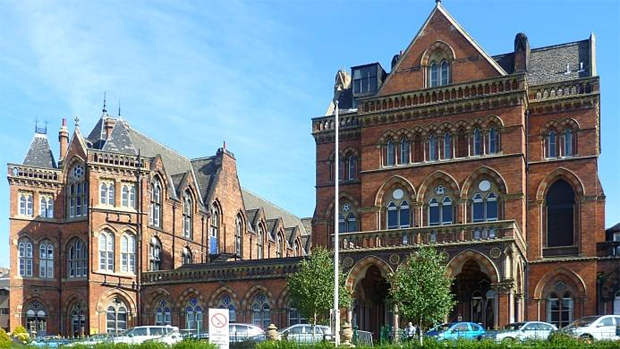
Leeds General Infirmary
Extract from “Wicked Beyond Belief” by Michael Bilton (Pages 315 to 317):
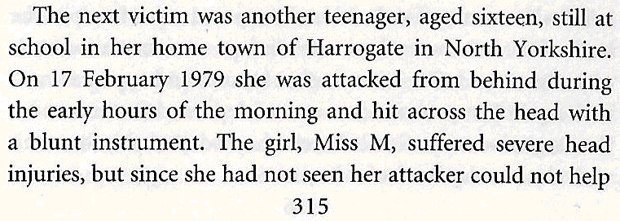

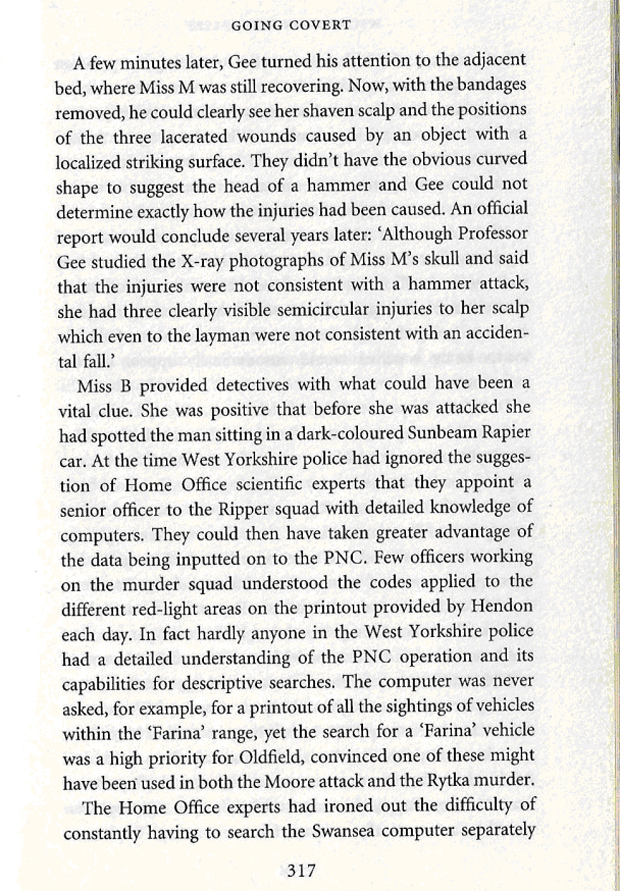
The attack on “Miss M” had a number of similarities to one of Sutcliffe’s gruesome Modus Operandi:
- The victim was an unaccompanied woman walking at night.
- The attack was launched on foot from behind.
- The victim was completely unaware that she was being followed and there was no conversation prior to the attack.
- Sutcliffe used variously a ball pein, masonry/walling/lump hammer or a claw hammer in his attacks. The injuries described to Professor Gee by another Doctor above are consistent with a claw hammer. (See Table 3 in Yorkshire Ripper – How Many Victims?). One blow hitting with the curved side of the claw at the back of the head, the other two from side to side blows connecting with the straight edge of the top of the hammer between the claw and the rounded striker.
- The location was within easy travelling distance of Sutcliffe’s home and work in Bradford.
- The attack took place in an area Sutcliffe was familiar with. Sutcliffe knew Harrogate and its road system because he did some of his HGV driver training there and travelled through Harrogate in his work as a lorry driver. He had also amassed a collection of A – Z street maps, to ensure that he could find his way around in urban areas.
- By 1979 Police activity in Sutcliffe’s normal hunting grounds in the Leeds, Bradford, Halifax and Manchester red light districts was intense. In January 1981 Sutcliffe moved his geographical area of operations to Sheffield in South Yorkshire, probably to escape it. He may also have changed his geographical area of operations to Harrogate in North Yorkshire in 1979 for the same reason.
So far as I can ascertain, no one has been arrested for this attack and no other suspect was ever identified.
Some comparisons to the attack on Miss Ann Rooney
Sutcliffe struck next on Friday evening 2nd March 1979 in the grounds of Horsforth College, Horsforth, Leeds. (Sutcliffe was to confess this crime in 1992). The victim was referred to as the Irish Student and as “Miss B” in the extract from “Wicked Beyond Belief” above). She was Ann Rooney a 22 year old student.
She was attacked from behind in the mid-evening. Miss Rooney was struck on the head three times leaving distinctive semi-circular wounds which were established to have come from a round hammer. She sustained no other injuries because Sutcliffe was disturbed and scared off.
This attack was identical to the attack in Harrogate on the 16 year old student (referred to as “Miss M” in the extract above) -less than two weeks before- on the 18th of February 1979.
Astonishingly, the police did not include this attack in the ‘Ripper’ series, based on the extremely narrow criterion that the hammer was a different size to the hammer the “Yorkshire Ripper” was using. Although Sutcliffe had had variously used a pein hammer, a claw hammer and a walling hammer to date.
Summary. Was it Sutcliffe?
So there you are. In summary there appear to be three options. Either:
- That there was no crime because the victim’s injuries were caused by slipping on ice.
or
- There was a crime but Peter Sutcliffe did not commit it. In which case the inevitable (but incredible) conclusion is that there were two maniacs operating in Yorkshire in 1979. According to this hypothesis they were unknown to each other, but had independently developed identical modus operandi launching unprovoked attacks on foot from behind at night, smashing the back of unaccompanied women’s skulls in with a hammer. One was Peter Sutcliffe; the other is an entirely separate person unknown to the police and who evaded detection, whom the NYE has dubbed “The Harrogate Ripper”. There were no similar attacks in Harrogate. There were no similar attacks anywhere else, once Peter Sutcliffe was arrested in January 1981.
or
- Peter Sutcliffe committed this offence.
I will leave our readers to come to their own conclusions on this.
The wider implications of this case for North Yorkshire Police
It should be remembered that the release of the Byford Report in 1981 led to a furore, with calls in Parliament and the press for Chief Officers to be sacked. The victim’s name was never released by North Yorkshire Police and the case has been shrouded in secrecy – thereby witholding from the public the extent of NYP’s involvement in the Yorkshire Ripper investigation and conveniently evading any criticism for it.
Concerning the last point. It is in the nature of police officers to protect the reputation of their force no matter what. The Ripper investigation was no exception. Loyalty is usually a commendable quality, but on some occasions it can become perverted. Assistant Chief Constable Jim Hobson of West Yorkshire Police who led the investigation can be seen defending the investigation and describing all criticism of WYP as “ridiculous” here. However, Sir Lawrence Byford’s investigation found there had been serious failings in the conduct of the investigation and that the criticism of the WYP investigation was in fact accurate. The implication being that historically there has been a cultural reluctance amongst many police officers to admit to failings in the police. Particularly if these failings refer to their own force. (Sir Lawrence Byford was an exception to this. He acted with commendable impartiality and integrity throughout).
Regrettably, the NYE had a similar response from NYP and the IPCC, when the NYE revealed that the former Mayor of Scarborough Peter Jaconelli and Jimmy Savile had been abusing children openly in Scarborough, with the full knowledge of North Yorkshire Police. The relentless determination of NYP not to investigate it, or admit to any failing was palpable. In the Jaconelli/Savile case NYP initially claimed that Jimmy Savile had no connections to North Yorkshire. It eventually conceded this was wrong and that in fact Savile lived in Scarborough. However, a report by Assistant Chief Constable Sue Cross then claimed there was no evidence of any offending by Savile or Jaconelli. Only a BBC investigation forced NYP to admit the truth and that the NYE Team was right. Thereby revealing the existence of a major paedophile ring in Scarborough and effectively quashing the findings of the Cross Report. BBC reports here and here.
Because of the original conclusion by North Yorkshire Police that the victim had slipped on the ice, the case never had the degree of publicity or police attention it deserved. It is not clear when NYP conceded that it was a crime, but it appears that there may not even have been an appeal for witnesses.
Since November 2016 North Yorkshire Police has a Major Investigation Team which is jointly manned with Cleveland Police, to tackle the most complex and serious crimes. It includes a specialist nine man Cold Case Review Team.
North Yorkshire Police has recently had a number of impressive successes in cold case investigations. Some examples can be seen here and here. NYP has also shown itself to be very skilled in appeals for witnesses and media operations on cold cases. Essential aspects of this type of investigation. Some examples can be read here, here and here.
The authors believe that this article could generate fresh interest in the case and that this could conceivably result in fresh evidence. Accordingly – acting openly and in the public interes t- NYP were provided with a draft of the article, and asked to provide a press comment for publication. We also offered NYP the opportunity of issuing an appeal for information timed to coincide with the publication of this article – the hope being that, even now, the fresh publicity and any interest generated by the article, may produce fresh evidence that may help NYP resolve the case.
One would have thought that any Cold Case Review Team would have jumped at the chance of fresh publicity on a long outstanding serious crime. However, our offer was ignored. It seems inexplicable that NYP will not accept any help which will generate fresh publicity and public interest, which may assist an investigation into a serious crime. Until, that is, you consider that any fresh investigation would reveal the incompetence in the original investigation – thereby causing embarrassment to North Yorkshire Police and the original investigating officers, some of whom are still alive.
One cannot help but conclude that the same historical reluctance to investigate a cold case that could result in criticism of the police, still exists in some quarters of North Yorkshire Police.
NYE appeal for information on the Yorkshire Ripper.
Were you in Harrogate, or working in the Leeds General Infirmary in 1979?
If you think you can add to our analysis above, or have information on the Harrogate attack, please contact the NYE using our e mail address: news@nyenquirer.uk.
The NYE would like to thank John Blake Books for permission to use material from “Yorkshire Ripper The Secret Murders”.

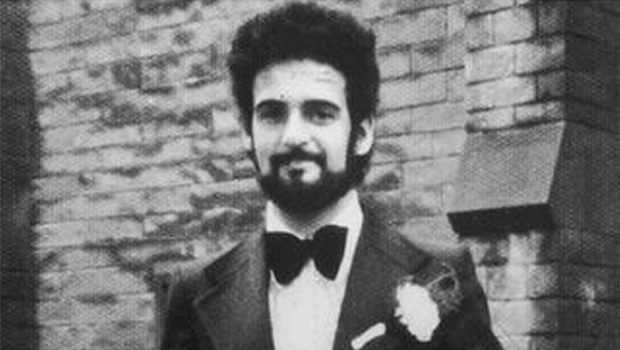





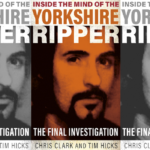


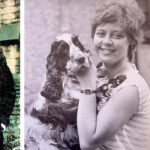
















Comments are closed.